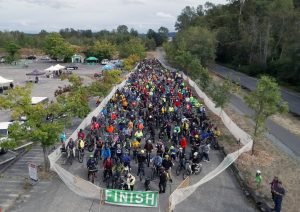 Did you know the Guinness World Record for the largest parade of electric bikes was set in Seattle?
Did you know the Guinness World Record for the largest parade of electric bikes was set in Seattle?
In 2018, Cascade Bicycle Club and Rad Power Bikes hosted 405 e-bikers (previous record held at 271) for a 2-mile record-setting ride around Magnuson Park. Since then, e-bikes have continued to win over riders of all ages, backgrounds, and communities.
Experts say “good quality e-bikes” have starting costs of about $1,500, but bike share options allow us to experience the benefits of e-biking at a much more affordable rate. Currently, JUMP bikeshare is available in Seattle. In 2010, there were only four bikeshare systems nationwide. Nine years later, a survey showed one in four Seattleites used bikeshare in 2019, leading the Seattle Department of Transportation to report that “the number of people using bike share has been as high as one of King County Metro’s top 10 most ridden bus lines.” Furthering the excitement, NACTO (National Association of City Transportation Officials) reports that e-bikes on average are used twice as much as pedal bikes. In the words of Marcia Griffiths, “You can’t resist it, it’s electric, boogie woogie woogie.”
The pandemic propelled U.S. e-bike sales by 145% in 2020. Here are a few reasons why:
- The pedal-assist make it easier for seniors and physically limited individuals go on longer rides and champion hills
- More capability to carry groceries, children, and cargo
- Improved physical and mental health benefits – a study showed only a 10bpm difference between electric and conventional bikes!
- The cost savings compared to vehicle ownership
- The positive environmental impact
Are you thinking about purchasing your first e-bike? Maybe you want to share some tips with your coworkers and encourage them to make the shift?
The Washington Post and Cycling News have great tips for how to buy one! To summarize, here is a quick list:
1. Think about how you’re going to ride most of the time – On trails? With kids? To commute?
2. Choose from one of three e-bike classifications:
Class 1 bikes can go up to 20 miles per hour
Class 2 bikes can go up to 20 miles per hour and have throttle assistance
Class 3 bikes can go up to 28 miles per hour
3. Test ride to familiarize yourself with the frame that gives you maximum comfort.
4. Know where you’ll park your e-bike. It can weigh 38-70 pounds and not all batteries are easily removable to charge.
5. Have a budget. Costs can be anywhere from $600 to $15,000.
6. Select your bike shop wisely. Are they asking you all the right questions? Does the bike tick all your boxes?
7. Make sure you have a helmet and lights! Maybe a rack to haul your groceries.
8. Don’t forget to learn about your e-bike! Know how it works, so you can maintain it.
Cascade Bicycle Club offers e-bike classes for groups of 2-4!
Learn about maintenance, chains, derailleurs, and how to fix a flat.
